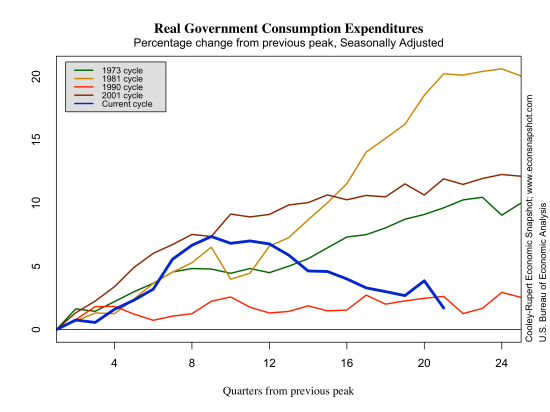The BEA announced May PCE (Personal Consumption Expenditure) data that reinforces the earlier CPI (Consumer Price Index) report: Inflation continues to creep down. Annualizing the month-over-month change in the PCE, inflation for May was 1.55%, well below the Fed’s 2% target. As we have commented before, these month-to-month changes contain a lot of noise and our preferred measure is the annualized 3 month change. By this measure, inflation for May was 2.45% – somewhat higher than the 2.2% reported earlier for the CPI. The headline year-over-year PCE inflation rate for May was 3.85%. As we have emphasized in previous posts, this year-over-year measure of inflation is slow to respond to changes in trend which means it will take some time for the year-over-year inflation rates to reflect the lower inflation rates that have come in over recent months.

Less rosy is the inflation picture coming from core PCE (that is, excluding food and energy). While the month-over-month rate was down in May – from 4.65% to 3.84% – the year-over-year and 3 month measures fell by roughly 0.1 percentage points. Presumably, the reason to look at core PCE inflation is that it provides a better gauge of underlying trend inflation than non-core PCE measures. But for our money, the 3 month PCE inflation rate does a good job capturing developments in trend inflation.

For June, expected inflation is now running below 2% at all horizons. Collectively, the results for CPI, PCE and expected inflation suggest that the tightening of monetary policy over the past year-and-a-half has brought down both actual and expected inflation. In this context, the Fed’s decision in June to pause its tightening of monetary policy seems like a good one, especially if one takes into account the well-known long and variable lags of the effects of monetary policy on the economy.

Finally, while we at Economic Snapshot usually do not comment on GDP (Gross Domestic Product) revisions, we are making an exception for the data released on Thursday by the BEA. The output revision was a very large 0.7 percentage points, from 1.27% to 2.00%. This upward revision of output can be attributed to upward revisions in consumption and exports, and a downward revision of imports (which has a positive effect on output since imports are subtracted from output). These effects were partially offset by small revisions in investment and government spending.
| Second Revision | Third Revision | Difference | |
| Output | 1.27 | 2.00 | +0.73 |
| Consumption | 2.65 | 2.93 | +0.28 |
| Investment | -2.10 | -2.17 | -0.07 |
| Government | 0.88 | 0.85 | -0.03 |
| Exports | 0.66 | 1.00 | +0.33 |
| Imports | -0.75 | -0.37 | +0.38 |
The increase in real GDP was widespread according to the state GDP estimates. Real GDP increased in all 50 states in Q1. The largest increase came in North Dakota, 12.4% at annual rate and the lowest in Rhode Island and Alabama at 0.1%. Personal income increased in all but two states, Indiana (-1.0%) and Massachusetts (-0.9%).

































